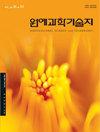无机基质对水培系统中褐花葵水质及生长的影响
IF 1
4区 农林科学
Q3 HORTICULTURE
Korean Journal of Horticultural Science & Technology
Pub Date : 2023-04-30
DOI:10.7235/hort.20230018
引用次数: 0
摘要
底物对植物生长很重要,因为它们维持水共生系统中的水质。本研究的目的是研究海绵(SS)、兰石(SO)、水球(SH)和火山岩(SV)四种无机基质对植物盆栽(室内设计中使用的植物)水培系统的影响。采用循环深流系统。将kalanche blossfeldiana ' Peperu '幼苗和金鱼(Carassius auratus auratus)放在一个分成两部分的小水箱中,一起饲养50天。每天在每个鱼缸中添加0.25 g鱼饲料。定期检查水的电导率(EC)和pH值。测定了水培水的营养浓度和植物的生长参数。结果表明,在不同处理下,EC强度随时间的增长规律是相同的。每次处理后,水的pH值在不同的范围内波动。各处理15 ~ 20 d间,水培水体NH4+浓度急剧上升,之后趋于稳定。处理15 ~ 20 d后,NO3 -和Mg2+离子浓度也急剧升高;后来,发现在SH、SS和SO治疗中NO3 -增加。然而,在处理后35 d, Mg2+和Ca2+在所有处理中都表现出相似的稳定浓度趋势。在所有处理中,Ca2+和HPO42 -浓度呈反比关系。不同处理的花楸株高、株宽和茎粗差异不显著。叶片数量、叶片长度和叶片宽度在不同处理间也无统计学差异。处理开始后50 d, SH处理植株的SPAD值高于其他处理。不同处理的植株枝数、节数和花数均无显著差异。上述结果表明,无机海绵、兰花石、水球和火山岩基质对水培水的EC、pH和离子浓度均有影响。此外,头20天对确保水中离子浓度稳定至关重要。然而,这些基质对黄毛菊的生长没有显著影响。本文章由计算机程序翻译,如有差异,请以英文原文为准。
Effect of Inorganic Substrates on the Water Quality and Growth of Kalanchoe blossfeldiana in an Aquaponic System
Substrates are important for plant growth as they maintain the water quality in an aquaponic system. The aim of this study was to investigate the effects of four inorganic substrates of sponge (SS), orchid stone (SO), hydroball (SH), and volcanic rock (SV) on an aquaponic system for planterior (use of plants in interior design) purposes. A recycling deep flow system was used. Kalanchoe blossfeldiana ‘Peperu’ seedlings and goldfish (Carassius auratus auratus) were kept together for 50 days in a small tank divided into two sections. Every day, 0.25 g of fish feed was supplied into each tank. The electrical conductivity (EC) and pH of the water were checked regularly. The nutrient concentration of the aquaponics water and the plant growth parameters were measured. The results showed that the increasing pattern of the EC strength over time was identical under the different treatments. The pH of the water fluctuated with different ranges for each treatment. Furthermore, the NH4+ concentration in aquaponic water increased sharply from 15 to 20 days in all treatments, later becoming more stable. The NO3‒ and Mg2+ ion concentrations also sharply increased after 15 to 20 days of treatment; later, NO3‒ was found to have increased in the SH, SS, and SO treatments. However, at 35 days after treatment, Mg2+ and Ca2+ showed a similar stable concentration trend in all treatments. An inverse relationship was observed between the Ca2+ and HPO42‒ concentrations in all treatments. Plant heights, widths, and stem diameters of K. blossfeldiana were not significantly different among the treatments. The number of leaves, the leaf length, and the leaf width of the plants were also not statistically different among the treatments. At 50 days after the commencement of treatment, the SPAD value of plants was higher in the SH treatment than in the others. Furthermore, the numbers of branches, nodes, and flowers of plant were not significantly different among the treatments. These results indicate that the inorganic sponge, orchid stone, hydroball, and volcanic rock substrates influenced the EC, pH, and ion concentrations in aquaponics water. In addition, the period of the first 20 days is crucial to ensure stable ion concentrations in water. However, these substrates did not significantly affect the growth of K. blossfeldiana.
求助全文
通过发布文献求助,成功后即可免费获取论文全文。
去求助
来源期刊
CiteScore
2.00
自引率
0.00%
发文量
0
审稿时长
1 months
期刊介绍:
Horticultural Science and Technology (abbr. Hortic. Sci. Technol., herein ‘HST’; ISSN, 1226-8763), one of the two official journals of the Korean Society for Horticultural Science (KSHS), was launched in 1998 to provides scientific and professional publication on technology and sciences of horticultural area. As an international journal, HST is published in English and Korean, bimonthly on the last day of even number months, and indexed in ‘SCIE’, ‘SCOPUS’ and ‘CABI’. The HST is devoted for the publication of technical and academic papers and review articles on such arears as cultivation physiology, protected horticulture, postharvest technology, genetics and breeding, tissue culture and biotechnology, and other related to vegetables, fruit, ornamental, and herbal plants.

 求助内容:
求助内容: 应助结果提醒方式:
应助结果提醒方式:


